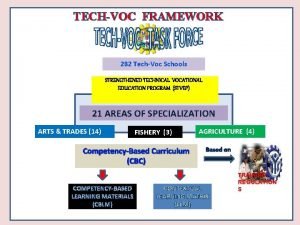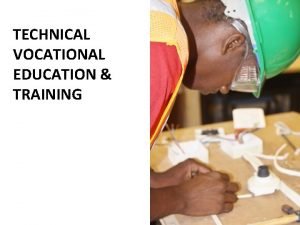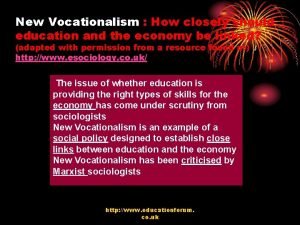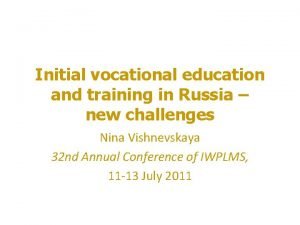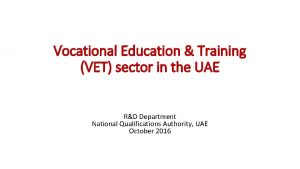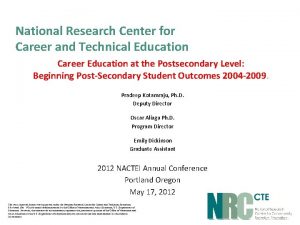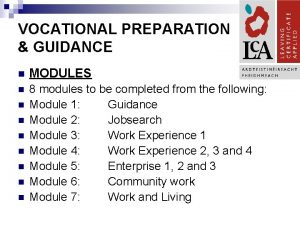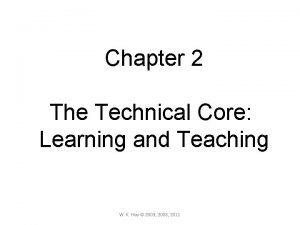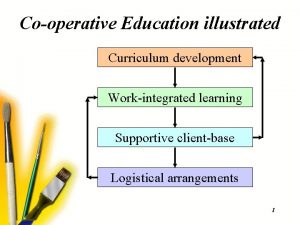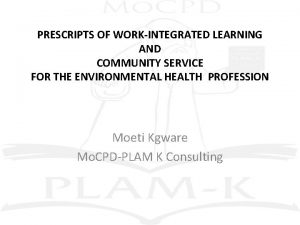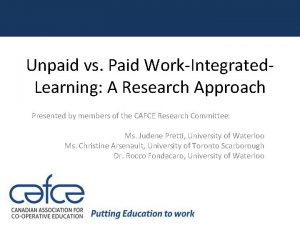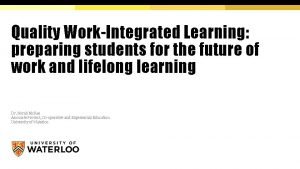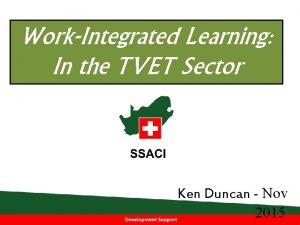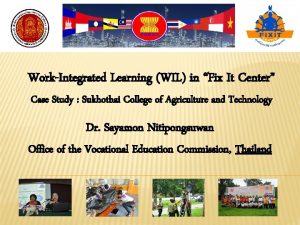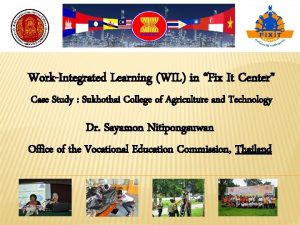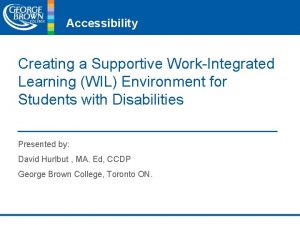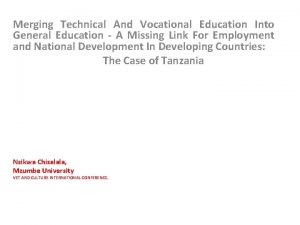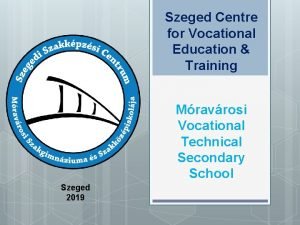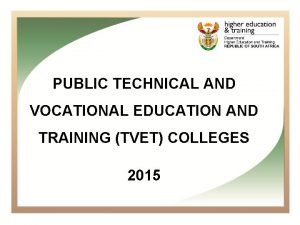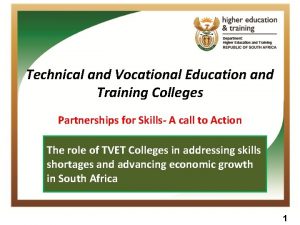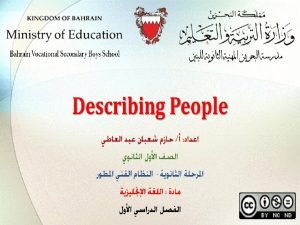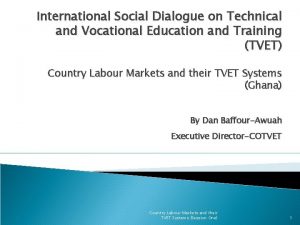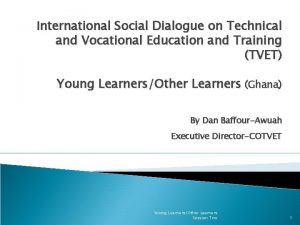IMPLEMENTING WORKINTEGRATED LEARNING IN TECHNICAL AND VOCATIONAL EDUCATION

























- Slides: 25

IMPLEMENTING WORK-INTEGRATED LEARNING IN TECHNICAL AND VOCATIONAL EDUCATION AND TRAINING COLLEGES

BACKGROUND TO SSACI

SSACI’s Core Business Work Integrated Learning (WIL)

Closing the gap between work and learning c o l l e g e s Guest Lecturing Lecturer WIL Assessing WIL WBE/WIL FOR STUDENTS B u s in e s s

Focus of SSACI’s support to colleges Encourage colleges to establish college- industry partnerships Align the general vocational curriculum closer to the needs of industry Work at institutional level to embed WIL in the college system Share lessons with DHET to embed WIL in the national vocational system

Introduction – A context for WIL NSDS 3 The White Paper WIL NDP National Skills Accord

Ministerial Commitment The provision of WIL forms part of the delivery agreement to which the Minister of Higher Education and Training committed himself in 2014. Output 3 of that agreement, “Access to occupationally directed programmes”, is directly related to WIL at TVET colleges. The fourth indicator of this output reads: “Percentage placement rate of learnerships, apprenticeships, and NC(V) students into workplace experience: 70% by 2014. ”

As a result, since 2012, the provision of WIL has been a key performance area for public TVET colleges. The Department of Higher Education and Training’s (DHET) Monitoring and Evaluation: Quarterly Reporting Guidelines for Data Collection and Capturing requires colleges to report on their placement of: students in learnerships and apprenticeships N 6 graduates in internships NC(V) and Report 191 students in workplace- based experience lecturers in workplace exposure

Why integrate work and learning? combines learning and work is a structured programme that provides direction to work and learning students are mentored under real work conditions WIL combines learning both hard and soft skills in a real - world environment Save costs for the employer when students are productive NB ! On- the job is not always the place to start learning about real work – progress towards it

Defining WIL Work-integrated learning (WIL) means learning that takes place through the medium of work. The difference between work-integrated learning and any other kind of learning is the presence or absence of real work. The purpose of WIL in TVET colleges is to develop the students’ competence (i. e. their ability to apply knowledge and skills to the tasks and demands of the workplace) and to improve their employability.

Who are the beneficiaries of WIL and how do they benefit? students/trainees/learners employers colleges

Why WIL matters to students: Post-secondary education/ Occupational training skills as practised in the workplace Workplace behavioural skills Workplace connections Jobs

Why WIL matters to institutions: Better inputs Instructors: • Industryexperienced Curricula: • Industry-aligned Students: • Workplace experienced lead to…. improved outputs Pass rate Throughput rate Employability

Why WIL Matters to Business Productive and Cost-effective hire for the duration of WIL Avenue for an enhanced screening process for potential employees Reduced recruitment and induction costs ( tax breaks and BBBEE scorecard points) Development of a culture of Learning within the organisation Opportunity to influence college curricula and be influenced by it (especially in terms of new ideas, systems, processes and technology)

Relative Amounts of Time Spent in the College and in the Workplace in Different Programmes Workplace -Based Experienc e (WBE) Work exposure Apprentices hip Learnershi p Internship Time in college (supervised by lecturer) Time in workplace (supervised by employer)

KEY FEATURES OF WIL programmes in TVETs …include theoretical, practical and workplace components The theory training component is organised and progressive and is presented by a TVET college or other accredited education and training provider. …practical training component may be presented at a TVET college or a training centre attached to or independent of a workplace component is planned, structured and ideally takes place in a real workplace

…workplace component should promote learning as much as theoretical and practical training components. This occurs through the application of knowledge and skills in the context of real work The workplace component may be provided before theoretical and practical training components are presented (pre-course), simultaneously with their presentation (on-course) or afterwards (post-course). The theory, practical and workplace components must be structurally linked and reinforce one another. Integration of knowledge and skills runs two ways: from the classroom and practical room to the workplace and vice versa. The workplace component can include one or more periods in a workplace and can vary in duration

WIL programmes do not necessarily lead to formal qualifications but always include some form of performance assessment which is likewise fit for purpose In addition to the formal assessments of students’ performance, each of the components may include activities that require the student to reflect upon what he or she has seen, done and learned, and how he or she intends to apply that experience in future

Phase 1: Planning Phase 2: Preparation WIL cycle Phase 4: Postplacement The WIL Cycle Phase 3: Placement

IMPLEMENTING WIL – Guiding Principles Principle 1 All core programmes to include WIL Principle 2 Systematic Planning – part of the institutionalising of WIL Principle 3 Suitable workplaces that are able to provide the required experience in a safe and healthy environment colleges must e strive to address the skills needs of local employers and accommodate their business objectives, operating procedures, work processes, calendars, timing and managerial systems Principle 4 Principle 5 longer and more frequent the workplace-based components of a WIL programme, the more effective it is likely to be Principle 6 Good preparation of students and employers; each must know what is required of them and how to meet these requirements Monitoring of Students Principle 7 Principle 8 Monitoring and reporting are necessary for effective WIL implementation and compliance with DHET guidelines

SSACI’s lessons: Obstacles to WIL • Lack of employer participation is the single greatest constraint on WIL training in SA: a mindset problem • Colleges & employers find it difficult to engage with one another • Work standards at colleges are generally not aligned to industry, especially for practical skills • Govmt policies affecting WIL need to be more coherent & better aligned within & across ministries • Administration of WIL in colleges, companies & SETAs is alarmingly weak

Where to now? • WIL must be seen as essential for aligning TVET system to industry and to improving students’ employment prospects • Expanding WIL is therefore in the interests of the state, the economy, TVET institutions & students • To expand WIL, a mindset change is required of industry &, therefore, the business case must be made • Organisation & funding of WIL must be built into public TVET programmes

• • A favourable tide for CIPs National Skills Accord commitments New DHET emphasis on CIPs: • “Partnerships between colleges & employers… will be encouraged & strengthened” (DHET: White paper 2013) • Workplace experience for lecturers & students key performance indicators in M&E framework • WPBL Framework for post school sector • SSACI’s TVET Guidelines on WIL adopted by the DHET - 2015 • WIL to be included in Colleges teaching and learning plan - 2016 • Proposed new BBBEE regulations recognise wide range of training of non-employees • NSDS 3 – pivotal programmes

Questions

Thank You! Contact Shanita Roopnarain or Ken Duncan at 011 6422110 shanita@ssaci. org. za/ ken@ssaci. org. za
 Definition of tech-voc
Definition of tech-voc Technical training definition
Technical training definition Cvschools
Cvschools Criticisms of vocational education sociology
Criticisms of vocational education sociology Dr kothari commission
Dr kothari commission Recommendations of secondary education commission 1952-53
Recommendations of secondary education commission 1952-53 Vocational education in russia
Vocational education in russia Elearning adveti
Elearning adveti Smith-hughes national vocational education act
Smith-hughes national vocational education act Vocational in a sentence
Vocational in a sentence Criticisms of vocational education
Criticisms of vocational education Cuadro comparativo e-learning m-learning b-learning
Cuadro comparativo e-learning m-learning b-learning Implementing strategies management and operations issues
Implementing strategies management and operations issues Mis issues in strategy implementation
Mis issues in strategy implementation Implementing strategies: management and operations issues
Implementing strategies: management and operations issues Tripod of pricing
Tripod of pricing Designing and implementing brand marketing programs
Designing and implementing brand marketing programs Designing and implementing brand architecture strategies
Designing and implementing brand architecture strategies Crm vision statement example
Crm vision statement example Matching structure with strategy
Matching structure with strategy Toyota brand hierarchy
Toyota brand hierarchy Implementing strategies management and operations issues
Implementing strategies management and operations issues National research center for career and technical education
National research center for career and technical education Vocational preparation and guidance
Vocational preparation and guidance Technical core
Technical core Implementing hrd programs
Implementing hrd programs
